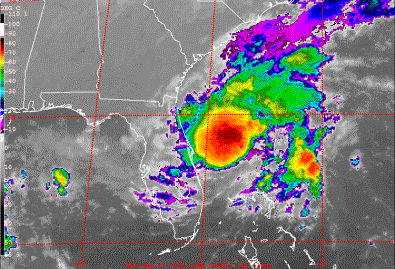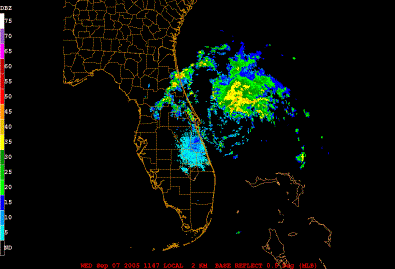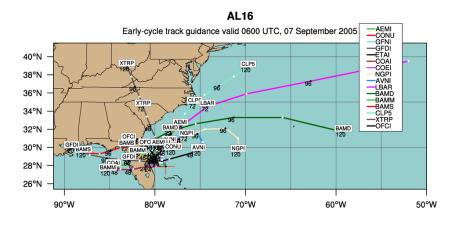IFEX daily log
Wednesday, September 7, 2005
N43RF was tasked for a flight into T.D. #16, with fix responsibilities of 06, 09,
and 12 UTC. Takeoff time would be at 0430 UTC on September 7. Since the original
plan called for this pattern to be flown at 5000 ft, it was decided to piggyback a research
mission onto this tasked mission. Because of the near 12-h staggering between missions,
and the tasking of N42RF and N43RF on the following days, this would make an
excellent 12-h Frequent Monitoring Experiment.
The mission involving N43RF consisted of a rotating figure-4 pattern, with the
initial point 105 nm northwest of the center. The first two passes would be flown at 1500
ft, and then the plane would climb to 5000 ft for the final pass. Sondes would be dropped
only from 5000 ft, at the turn points and the midpoints of that radial leg. The tail radar
would be run in F/AST mode for most of the pattern, except for the second half of the
first inbound leg, when it was run in continuous mode.
The system was getting better organized while N43RF was in there. The pressure
dropped to 1003 hPa during the flight, it was hence upgraded to Tropical Storm Ophelia.
Banding was evident of the north, east, and southeast sides of the storm. The center was
still located south of the convection, but it may be repositioning itself further north.
N43RF was able to fly some of a frequent-monitoring experiment. Because much of the
pattern was flown at 1500 ft, there were no drops, but there was radar coverage, at least
on the north side of the storm where there were scatterers. The aircraft did climb to 5000
ft and drops sondes south, at the midpoint, north, and on the final downwind leg. There
was also some limited vertical incidence data, and cloud physics data.
Tropical Storm Ophelia has slowly organized overnight. Satellite imagery
indicates a broad shield of cold cloud tops (Fig. 95) with outflow inhibited to the south,
indicative of some southerly shear impacting the system. A radar image from the
Melbourne radar (Fig. 96) shows the shield of convection extending fairly far north. A
band is also evident onshore in northern Florida. Track guidance for Ophelia (Fig. 97)
shows a wide spread. Some dynamical models (e.g., the Canadian global model) take
Ophelia out to sea, while other dynamical models, such as the GFDL, bring the system
over land and into the Gulf of Mexico. Such a wide spread is indicative of considerable
uncertainty.
Both NOAA P-3Ős are still tasked for fix/SFMR missions into Ophelia, separated
by 12-h frequency. The N42RF tasked mission will also have the NOAA Frequent
Monitoring and Ocean Winds experiments piggy-backed onto it. As in the previous day,
the plan called for a figure-4 pattern to be flown, this time at 5000 ft. The NRL P-3
would not accompany N42RF this time, however.

Figure 95. GOES-East infrared image valid 1115 UTC September 7 2005.

Figure 96. Melbourne WSR-88D reflectivity (shaded, dBZ) valid 1147 UTC September
7 2005.

Figure 97. Track guidance valid 06 UTC September 7 2005.
Rob Rogers
HRD Field Program director
Return to IFEX calendar page
![[Atlantic Oceanographic and Meteorological Laboratory]](../../../hrd_top_logo7.jpg)
![[OAR/DOC/NOAA Logos]](../../../oar_noaa_doc_logos3.jpg)